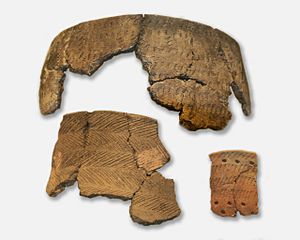Comb Ceramic culture facts for kids
 |
|
| Geographical range | North-Eastern Europe |
|---|---|
| Period | Mesolithic Europe, Neolithic Europe |
| Dates | c. 4200 – 2000 BCE |
| Preceded by | Narva culture |
| Followed by | Volosovo culture, Corded Ware culture, Kiukainen culture |
The Comb Ceramic culture (often called CCC or PCW) was an ancient group of people in northeastern Europe. They are known for their special pottery, which had patterns that looked like they were made with a comb. This culture existed for a long time, from about 4200 BCE to 2000 BCE.
These people were mostly hunter-gatherers. This means they found their food by hunting animals, fishing, and gathering plants. Even though they made pottery, they didn't farm much, which was unusual for groups in Europe at that time.
Contents
Where Did They Live?
The Comb Ceramic culture spread across a large area in northern Europe. You can find their artifacts from Finnmark in Norway in the north, all the way to the Vistula River in Poland in the south. Their territory also included parts of Sweden and Finland.
Some groups within this culture, like the Narva culture in Estonia, showed small signs of early farming. But mostly, these people were skilled at living off the land by hunting and gathering.
Their Special Pottery
The pottery made by the Comb Ceramic culture is very unique. In most parts of Europe, people started making pottery around the same time they began farming. But in Asia, pottery was made long before farming. The Comb Ceramic culture seems to have been influenced by these older pottery traditions from places like Siberia and China.
Their pots were usually large, holding about 40 to 60 liters. They had rounded or pointed bottoms. The basic shape of the pots stayed the same over time, but the decorations changed.
Scientists have divided the pottery into different periods based on how old they are:
- Early Comb Ceramic (around 4200 BC – 3300 BC)
- Typical Comb Ceramic (around 3300 BC – 2700 BC)
- Late Comb Ceramic (around 2800 BC – 2000 BC)
Some of their pottery even used asbestos to make the clay stronger. This special way of making pottery continued for a very long time, even into the Iron Age.
How They Lived
These ancient people usually set up their homes near the sea or by lakes. Their lives revolved around hunting, fishing, and gathering plants. In Finland, they were especially good at hunting seals.
Their main homes were likely teepee-like tents, about 30 square meters in size. Around 15 people could live in one of these homes. Later, around 4000 BC, they also started building rectangular houses out of wood in Finland.
They buried their dead right in their settlements. The bodies were often covered with a red powder called red ochre. Important items like tools made of flint and shiny amber were often placed in graves as offerings.
Their Tools and Trade
The tools used by the Comb Ceramic people didn't change much over many years. They made them from local materials like slate and quartz.
However, they also traded for materials from far away. For example, they got red slate from northern Scandinavia and green slate from Lake Onega. They also traded for amber from the southern Baltic Sea and flint from northwestern Russia. This shows they had a wide network for exchanging goods.
Ancient Art
The Comb Ceramic culture also created interesting art. They made small figures out of baked clay. They also carved animal heads from stone, often showing moose and bears. These animal carvings were similar to art made by even older cultures.
They also left behind many rock paintings. Some sources suggest that their pottery was not just useful but also beautiful, and that they enjoyed wearing fancy amber necklaces.
What About Their Language?
Scientists are not sure what language the Comb Ceramic people spoke. Some researchers used to think they spoke an early form of Uralic languages, which includes languages like Finnish and Estonian today.
However, other ideas suggest they might have spoken very old "Palaeo-European" languages. These would be languages that existed in Europe before the Uralic or Indo-European languages arrived. Today, many experts believe that the Uralic languages spread much later, long after the Comb Ceramic culture ended. So, the language they spoke remains a mystery!
Learning from Their DNA
Scientists can learn a lot about ancient people by studying their DNA. Researchers have looked at the DNA from some Comb Ceramic individuals.
These studies show that the Comb Ceramic people were mostly related to "Eastern Hunter-Gatherers." This group lived in eastern Europe a very long time ago. Their DNA also shows a mix of other ancient groups, like "Western Hunter-Gatherers" and "Western Steppe Herders." This helps us understand where these ancient people came from and how they were connected to other groups in Europe.
Images for kids
See also
- Pitted Ware culture
- Dnieper–Donets culture
- Rzucewo culture
- Pre-Finno-Ugric substrate
Sources






